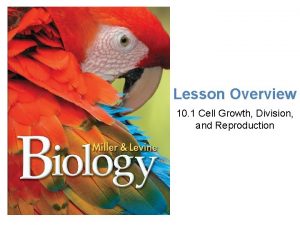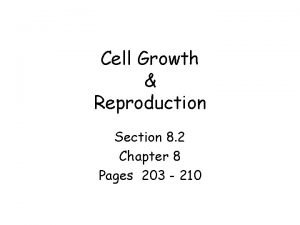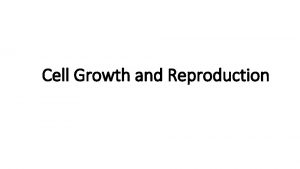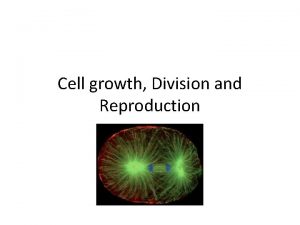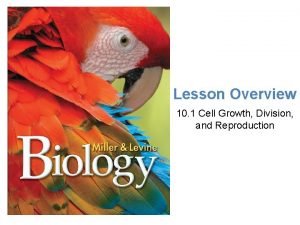Lesson Overview Cell Growth Division and Reproduction Chapter






- Slides: 6

Lesson Overview Cell Growth, Division, and Reproduction Chapter 11 Lesson Overview 11. 1 Cell Growth, Division & Reproduction

Lesson Overview Cell Growth, Division, and Reproduction Cell Growth Limitations • Information crisis: too many demands placed on DNA • Traffic problems: volume grows too fast relative to surface area, material exchange is insufficient

Lesson Overview Cell Growth, Division, and Reproduction Division of the Cell • Before a cell grows too large, it divides into two new “daughter” cells in a process called cell division. • Before cell division, the cell copies all of its DNA. • It then divides into two “daughter” cells. • Each daughter cell receives a complete set of DNA. • Cell division reduces cell volume. It also results in an increased ratio of surface area to volume, for each daughter cell.

Lesson Overview Cell Growth, Division, and Reproduction Asexual Reproduction • In multicellular organisms, cell division leads to growth. It also enables an organism to repair and maintain its body. • In single-celled organisms, cell division is a form of reproduction. • Asexual reproduction is reproduction that involves a single parent producing an offspring. The offspring produced are, in most cases, genetically identical to the single cell that produced them. • Asexual reproduction is a simple, efficient, and effective way for an organism to produce a large number of offspring. • Both prokaryotic and eukaryotic single-celled organisms and many multicellular organisms can reproduce asexually.

Lesson Overview Cell Growth, Division, and Reproduction Sexual Reproduction • In sexual reproduction, offspring are produced by the fusion of two sex cells – one from each of two parents. These fuse into a single cell before the offspring can grow. • The offspring produced inherit some genetic information from both parents. • Most animals and plants, and many single-celled organisms, reproduce sexually.

Lesson Overview Cell Growth, Division, and Reproduction Comparing Asexual and Sexual Reproduction Asexual § Produce many offspring in short period § Don’t need to find a mate § In stable environments, genetically identical offspring thrive. § If conditions change, offspring not well adapted. Sexual § Relatively fewer offspring; growth takes more time § Need to find a mate § In changing environments, genetic diversity can be beneficial. § Offspring may be less well adapted to current conditions.
